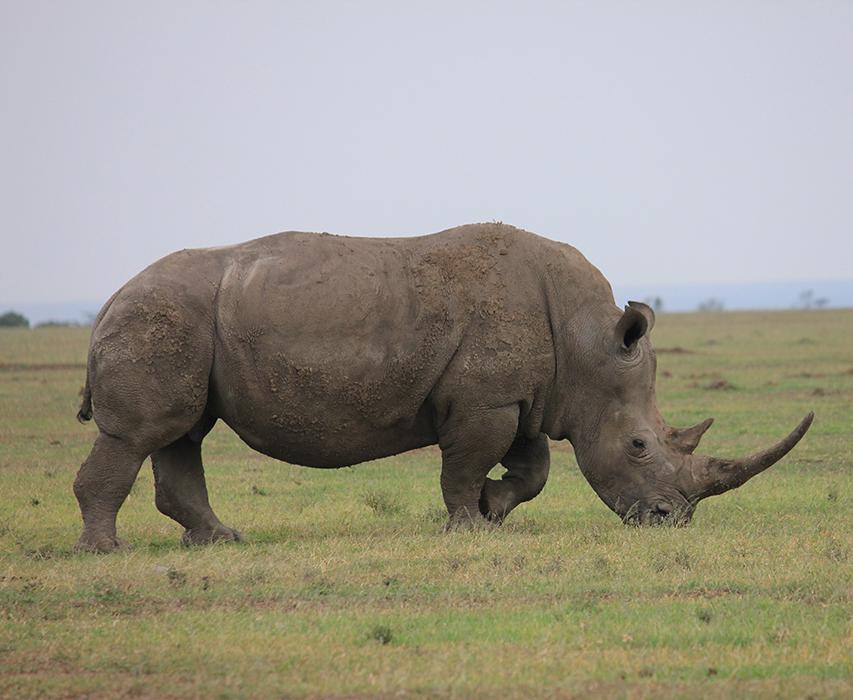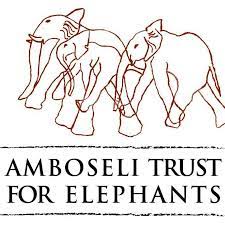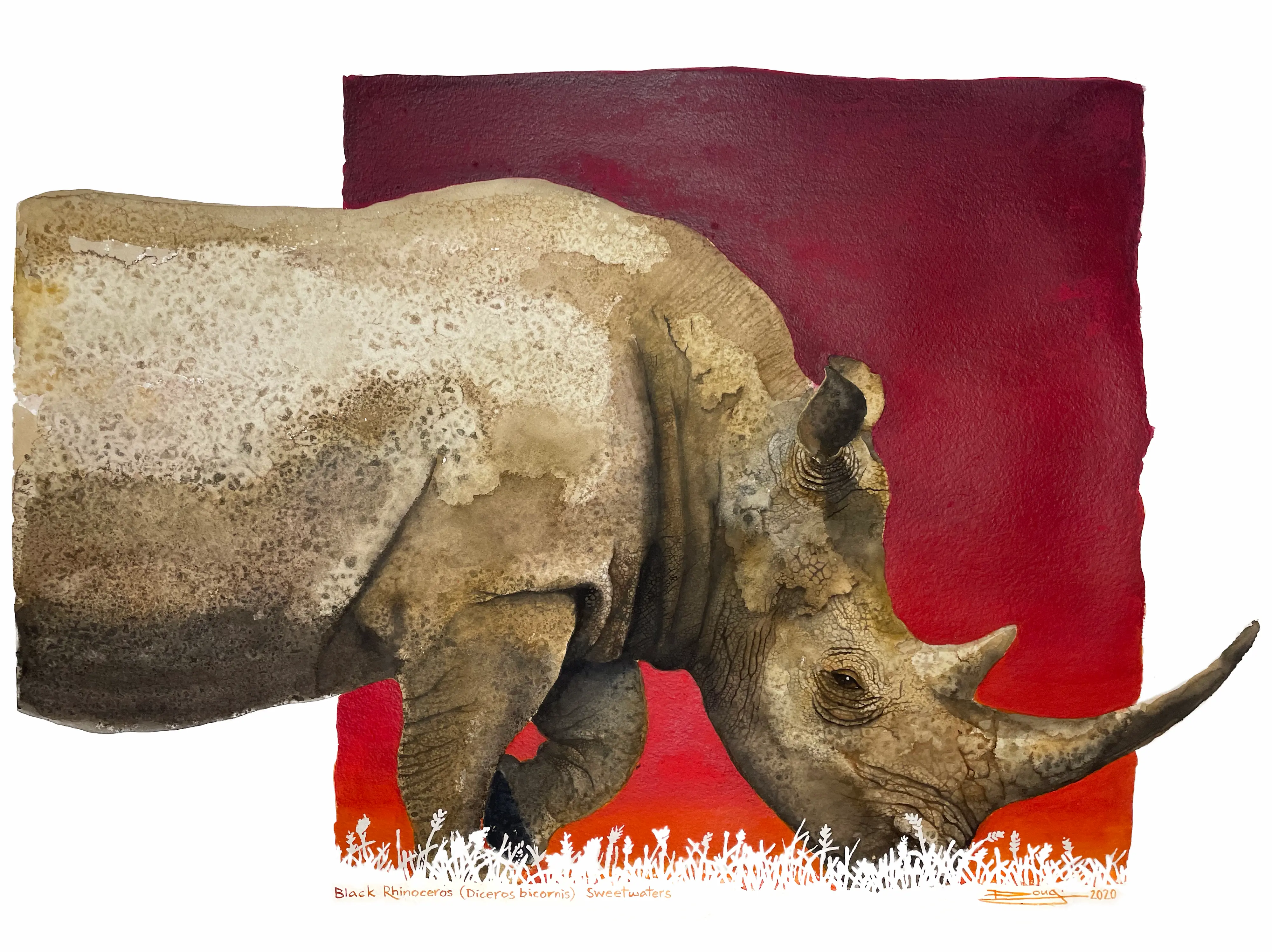Black Rhino, Sweetwaters, Kenya
Black rhinoceros (Diceros bicornis)
Watercolor, 30″ x 22″, on Arches rough 300 lb, 2020 $12,000.
About Black Rhinos
Black rhinos are the smaller of the two African rhino species. The most notable difference between white and black rhinos are their hooked upper lip. This distinguishes them from the white rhino, which has a square lip. Black rhinos are browsers rather than grazers, and their pointed lip helps them feed on leaves from bushes and trees. They have two horns, and occasionally a third, small posterior horn.
“Populations of black rhino declined dramatically in the 20th century at the hands of European hunters and settlers. Between 1960 and 1995, black rhino numbers dropped by a sobering 98%, to less than 2,500. Since then, the species has made a tremendous comeback from the brink of extinction. Thanks to persistent conservation efforts across Africa, black rhino numbers have doubled from their historic low 20 years ago to around 5,600 today. However, the black rhino is still considered critically endangered, and a lot of work remains to bring the numbers up to even a fraction of what it once was—and to ensure that it stays there. Wildlife crime—in this case, poaching and black-market trafficking of rhino horn—continues to plague the species and threaten its recovery.”
– World Wildlife Foundation
Rhinos at Ol Pejeta
I took the reference photo for this painting on a safari at Sweetwaters, home of the Ol Pejeta Conservancy, who are at the forefront of rhino rescue and conservation.They rescue Black Rhinos from across Africa and actively guard them from incessant attempts by poachers to kill them for their horns.
Ol Pejeta is also home to the last two surviving Northern White Rhinos and have partnered with an international consortium to attempt a revolutionary assisted fertilization project using frozen sperm from deceased northern white rhino bull Suni using a procedure called intra-cytoplasmic sperm injection (ICSI).
The consortium is led by Leibniz-IZW and funded by the German Federal Ministry of Education and Research (BMBF with additional smaller donors such as the Czech foundation Nadace ČEZ or the Richard McLellan Rewind Rhino Extinction Foundation from the USA. The consortium comprises internationally renowned institutions from Germany, Italy, Czech Republic, Kenya, Japan and USA.
Range Map of the Black Rhino
About the painting:
I started this project on my laptop, by compositing the rhino against a square flat panel of color, then sketching in a detailed outline using my pressure-sensitive Intuos graphics tablet. Once I had outlines that I liked I printed them out and taped them down to my large format lightbox. I use the lightbox rather than graphite transfer paper or pencil drawings to leave the watercolor paper free of any outlines.
I then taped over a 30” x 22” piece of Arches Rough 100% cotton watercolor paper. I used Van Gogh and Winsor & Newton paints, applying broad background washes first, which I eventually overpainted with acrylics to get a solid flatter and deeper background panel. I then laid in the base body and head textures using a combination of wet-on-wet, dry brush, and wet on dry washes. I used liberal amounts of sea salt to form the pebbled skin patterns then went back with a series of glazes to build up contrast and shadows, finally using a zero-size synthetic sable brush to render the details of the wrinkles, crevices, and dried mud patterns.
I only used three brushes for the entire painting, my Marie’s #6 pointed round synthetic sable (which comes to such a fine point, and holds so much media, that it is ideal for even hyper-fine details such as the skin pebbling between each wrinkle), and my Loew-Cornell 1″ oval flat, for larger washes. I used a 2″ Princeton synthetic mottler for the background wash, which I was unhappy with as it kept shedding black bristles everywhere!
The palette was limited to Alazarin Crimson, Hansa Yellow, Permanent Orange and Burnt Sienna, with touches of Prussian Blue and Payne’s Grey for depth. The pebbled texture was achieved by liberally sprinkling sea salt over very wet washes of color, then overpainting the resulting texture with fine lines to accentuate pebbling and define larger wrinkles and cracks.
I used Lanaquarelle 300 lb rough, from Legion Paper, after testing 7 different high-end watercolor papers to see which best suited my techniques of large, smooth gradient washes, wet-on-wet, deliberate blooms, seas salt application, multiple layers of glazing and spot lifting.
You can see the stage-by-stage progress in my CREATIVE PROCESS section.
I am donating 50% of the proceeds from an upcoming fundraising auction towards the Ol Pejeta Conservancy for their rhino programs.
My reference photo from Swweetwaters



